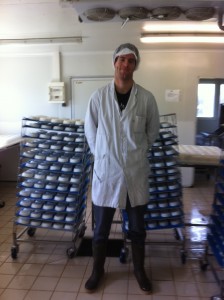 In this two-day work shop, Michael Kalish of Third Wheel Cheese Consulting, will guide you through European styles of affinage. Michael’s workshop finds its balance of theory and practice in a colorful blend of film, photography, interactive lecture, anecdotal experience, and hands-on demonstrations.
In this two-day work shop, Michael Kalish of Third Wheel Cheese Consulting, will guide you through European styles of affinage. Michael’s workshop finds its balance of theory and practice in a colorful blend of film, photography, interactive lecture, anecdotal experience, and hands-on demonstrations.
Michael Kalish co-founded Third Wheel Cheese Consulting in 2012. From 2008 to 2011, Michael worked on artisan cheese farms across France and Northern Italy and in the alps of Gruyère and Valle d’Aosta. Formally trained at the istituto lattiero caseario e delle tecnologie agro-alimentari in Italy’s famed Piedmont Region, Michael apprenticed for Luigi Guffanti, managed Hervé Mons’ Tunnel de la Collonge in the Rhône Alps, and ran operations for Artisanal Premium Cheese in NYC. Michael is on the Education Committee for the American Cheese Society Conference this year and will be leading panels on affinage and food safety in Sacramento. Michael has led workshops for the California, Oregon, and Wisconsin Artisan Cheese Guilds and has taught Affinage portions of Master Classes in NYC.
DATES: This is a two-day workshop, March 28 and 29th (Friday and Saturday)
SITE: Silvery Moon Creamery, Westbrook
FEE: $175 for Guild Members, $200 for non-members (includes a Guild membership). Registration will be set when deposits are received. Deposits will be refunded for cancellations up to a week before the class begins, after which they are not refundable. If there are more registrations than space available, later registrations will be notified and a waiting list will be started — deposits will be returned for those on the waiting list who cannot be accommodated.
To reserve a space, send a $50 deposit (with a note indicate the class you wish to attend) to:
Maine Cheese Guild
c/o Mark Whitney, Treasurer
Pineland Farms Creamery
92 Creamery Lane
New Gloucester, ME 04260
 Following is a Cheddar Cheese recipe that will end at the curd stage. It is adapted from Kathy Biss’s book
Following is a Cheddar Cheese recipe that will end at the curd stage. It is adapted from Kathy Biss’s book